1568 to 2018 AD: 450 years of Christianity in Mangaluru
1568 to 2018 AD: 450 years of Christianity in Mangaluru
Mangalore Today News Network
By I J Saldanha Shet
Mangaluru, Jan 6, 2017: 450 years - 1568-2018 AD Christianity is ever present in Kanara - The Church of Mangaluru is holding a Eucharistic Rally on Jan 7, 2018 to inaugurate this event and declare 2018 as the ’year of the Rosary’. "Mangalore Today" has published a special feature with the detailed history in it’s Dec 2017 issue. In parts of present Karnataka - Mangaluru and Udupi in particular, officially Christianity has been part of the culture as per records, from 1568AD.
This year 2018 accounts for 450 years.The influence wielded by various entities has surely influenced visibly, early clergy even until early 1900s was predominantly European - Italian and German, and their introduction of education provided the winds of change. Mangaluru has been a cradle of education for last 150 years or more. Now, Church in Mangaluru has declared 2018 as the year of the Rosary and will focus on Rosario Cathedral as the apex and Christianity in Tulunad.
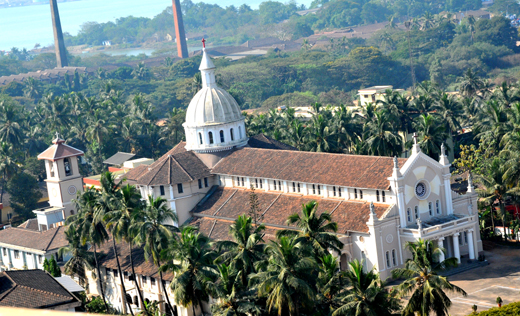
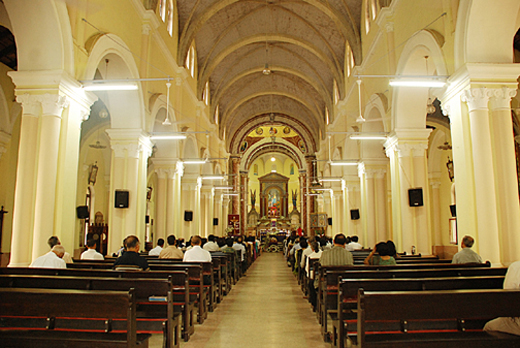
Early times 1568 AD:
Christianity first came to India within 20 years of Jesus Christ’s death at the age of 33 years, so to say in about 52.AD; thus it came to the Indian sub-continent even before it was known in many western countries. It was Christ’s close apostle one of the first twelve, St.Thomas, from Syria came over the Arabian sea, and landed in the extreme south of the West coast of India, what is now Kerala.
Centuries later, the Portugese touched Mangalore in 1530s, it took much effort to finally land on Mangaluru soil on January 5, 1568 in a trading pact with Tuluva rulers who gave space on the banks of river Nethravathi in the area now known as ’Halaya Kote’ in Bolar. Records indicate, Portuguese garrison consisted of not less than 200 men, the then Portuguese fort was named ’Sao Sabastiao’ (St.Sebastian). Reluctant converts to Christianity ’Sarasvats’ of Konkani origins from Goa, originally from the banks of the extinct river "Saraswathi", were brought here to work in the spice mills and agricultural lands. They were the early Christian population here who were later joined by mainly Konkani migrants who had reached Farangipete independently decades earlier. Within the fort was a settlement and small chapel, ’Nossa Senora de Rosario’, (Mother of the Rosary) that served the garrison. By the time of Pietro Della Valle’s visit in 1623, two more primitive chapels, served by Franciscan padres came up beyond the fort he notes. The first ’Rosario’ came to be known as the ’poyada ingreji’ (Tulu) or ’church on the sands’, and also ’factory church’ of the Portuguese. The memory of the Portuguese fort, however, lives on in the name given to the area ‘haleye kote,’(old fort) used even today. Much development has no doubt resulted in the area of the small original Mangaluru town that once lay between "Sharavu Ganapati" Temple just inside Kodialbail and "Mangaladevi" Temple in Bolar; the deity here has given this place it’s name "Mangala-uru", so Mangalore.
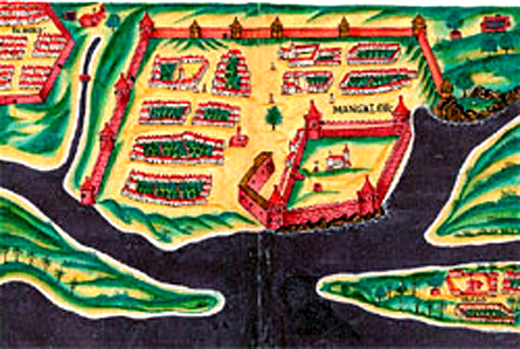
Konkani Catholics 1800-1915 AD:
The Roman Catholic faith in it’s present form took root in Mangalore from emigrant Konkani folk in the Potugese settlement around the commodity factories set up around the spot of the Portugese fort of St.Sebastian. The Konkani Catholics faced many trials and were grossly reduced in numbers by the advent of the ’Captivity’ under Tipu Sultan which ended in 1799; the faith stabilized in the 1800s and spread in all directions with many churches established and parishes formed - Kanara Vicarate was established by in December 1845 under Bishop Bernadine as Vicar Apostolic. Pope Leo XIII initiating a decree to set up a hierarchy in India and Mangalore became an independent Catholic diocese on January 25, 1887. The times 1800 to 1915, was a time of struggle and strife with wars, plague and economic poverty yet the Catholic Community rose up like an albatross from the ashes.
The Now - 1915-2018:
The Diocese of Mangalore is a dynamic and well organized integral part of the Universal Roman Catholic Church, Rosario Cathedral is it’s ’Mother Parish and Church’. In July 2012, the large active Mangalore diocese was bifurcated to form Udupi diocese, with the Kallianpur church declared as it’s Cathedral. Moves underway to bring in changes in Church matters universally under the guidance of Pope Francis and the Roman Curia.
Mangalore Diocese: At present is spread over an area of 5,924 sq.kms (2287 sq miles). with the Catholic population being 2.7 lakhs that is near 9 per cent of the total population in 115 parishes. It is considered the one institution that has kept Konkani as a language flourishing. The clergy/priests within it’s ambit are estimated to be 300 plus. Religious women/nuns now touches the 2000 mark in various dispensations. Further numbers of priests and nuns can be found serving other parts of the country and overseas. The entire region has benefited from this singular entity that stands in the name of God. The Diocese of Mangalore since 1887 for 130 years now gone by, has shown a remarkable upward trajectory in all spheres. The present Rosario Church was restored in the year 1813 in it’s present spot after the captivity and raised to the status of a ‘Cathedral’ in 1850, in 1915 the present edifice was completed and opened. Later a good number of Catholic churches and institutions flourish in Mangalore; The origins and development of the greater Mangalore Diocese (of which Udupi was part before 2012) and birth of many parishes stems from Rosario Cathedral. Pope John Paul II, set foot on the soil of Mangalore diocese on February 6, 1986 - the only time a Pope has visited here.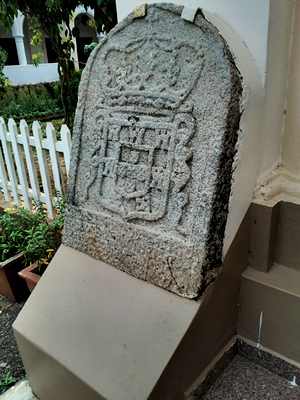 Rosario Cathedral: The inscription seen above the main entrance pillars and portico reads “1568 – Queen of the Rosary Bless India – 1915”. Basically this indicates, the first ever church of the area was established in 1568; the Cathedral is the mother church of the Diocese and seat of the Bishop. The present edifice was blessed in 1915. In year 2008, it’s inside look and surroundings have been given an aesthetic face lift. The Catholic Church and particularly the local faithful certainly have good reason to look upon this land as hallowed, glorifying and holy.
Rosario Cathedral: The inscription seen above the main entrance pillars and portico reads “1568 – Queen of the Rosary Bless India – 1915”. Basically this indicates, the first ever church of the area was established in 1568; the Cathedral is the mother church of the Diocese and seat of the Bishop. The present edifice was blessed in 1915. In year 2008, it’s inside look and surroundings have been given an aesthetic face lift. The Catholic Church and particularly the local faithful certainly have good reason to look upon this land as hallowed, glorifying and holy.
Some peripheral achievements, in the form of institutions located here are : St. Ann’s Convent, Apostolic Carmel (AC) Founding Institution -1870, St. Ursula Convent and Foundation House of the Mangalore Ursuline Sisters UFS - 1887. Rosario Education Indtitutions - 1868. and so on. Two great Catholic saints who lived in Rosario that Mangaluru has this good fortune to see two of it’s former religious residents to be declared saints in 2015 are St. Joseph Vaz and St. Mariam Baourdy.
Relics of Old Rosario Cathedral at Bolar: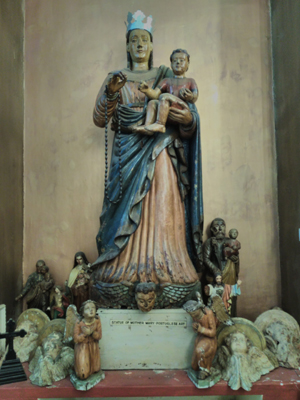 The Miracle Statue: The statue of Mother Mary of the Rosary - Rosario, which is said to have been on the altar of the early Rosario Church within the fort, ’Sao Sabastiao’, according to a prominent researcher on Tipu Sulthan, Alan Machado-Prabhu, mentioned it in his major book, is said to be the one presently in St Aloysius College Museum, see picture - tradition notes a statue was found floating on the sea off Mangalore. Statues have been known to have been found in other places along India’s coastline of the sub-continent. This statue, would have come from one of the numerous Portuguese ships that sailed along the coast. It could be the same statue that is said was hidden when Tipu’s army attacked the churches just before the captivity in 1784. How it survived is unclear, the fort was destroyed by Tipu. An expert comment on the statue, regarding its possible age and origin: “It is quite a beautiful image, very detailed, with lovely expression and in very good state. "I would date it from the late-16th century or 1st half of 17th (not truly Baroque) and by the parallel folds in the Lady’s dress it looks as of Ceylon origin, or by a Sinhalese sculptor in Portuguese Goa.”
The Miracle Statue: The statue of Mother Mary of the Rosary - Rosario, which is said to have been on the altar of the early Rosario Church within the fort, ’Sao Sabastiao’, according to a prominent researcher on Tipu Sulthan, Alan Machado-Prabhu, mentioned it in his major book, is said to be the one presently in St Aloysius College Museum, see picture - tradition notes a statue was found floating on the sea off Mangalore. Statues have been known to have been found in other places along India’s coastline of the sub-continent. This statue, would have come from one of the numerous Portuguese ships that sailed along the coast. It could be the same statue that is said was hidden when Tipu’s army attacked the churches just before the captivity in 1784. How it survived is unclear, the fort was destroyed by Tipu. An expert comment on the statue, regarding its possible age and origin: “It is quite a beautiful image, very detailed, with lovely expression and in very good state. "I would date it from the late-16th century or 1st half of 17th (not truly Baroque) and by the parallel folds in the Lady’s dress it looks as of Ceylon origin, or by a Sinhalese sculptor in Portuguese Goa.”Portuguese stones: Visit the Rosario Cathedral in Mangaluru, one stone visible is weather worn with a faint coat of arms of the Portuguese King Joao V pertaining to around 1712. Another stone, larger and with more visible details lies at the far unused right entrance of Rosario Cathedral, common factors can be deciphered. The larger stone proclaims the Portuguese presence at the old site at ’Halaya Kote - Bolar’, near the river edge opposite the confluence of the two rivers and the Arabian Sea; discouvered in March 2009, and narrated by "Mangalore Today". An ancient European relic. Decoding the inscriptions with the help of experts; the stone turned out to be the tombstone of Domingos de Mourao Coutinho, the captain of the Portuguese fort of Mangalore, he died on April 30, 1629. It is seen as an existing relic of the first church and fort which since 1568 formed a part of Mangalore’s Rosario church history and brings it to perspective. An expert assessment of this stone is that "It is about 1.8 x 0.7 mts, and bears the coat of arms of the Mourão Coutinho family, prominent nobles of 17th century of Northern Portugal. It is a tombstone etched with “Here lies Domingos de Mourão Coutinho, Captain of Fort Mangalor. He died on April 30, 1629.” Later this 1629 tomb stone was brought to the Cathedral premises, with a view of preserving it. So there it lies now and hopefully this Holy Year, 2018 AD, 450 year celebration will bring some light to the ancient relics of Rosario. The high lights of this section of the history of the Catholic Church in Mangaluru are noteworthy. From this history in part, stems the establishment and development of Konkani Catholic Christians of Mangaluru
- Need For ‘Students, Alcohol and Drugs’ survey
- New Synthetic Drugs Trapping Youth
- Mood Modifying Chips - Future of Drug Use
- Ramping up Indo-Bangla border security
- IITM- A premier educational Institution in a forest. What can we learn?
- Former PM, Manmohan Singh: Notable laws passed under his tenure
- Hashish on Ratnagiri Seashore
- The Poor cry out to Us: Do we respond?
- Clandestine Meth Labs Sprouting Across India
- Hydro ganja from Bangkok latest craze among youth in India
- "Memories to Treasure" Dr.Michael Lobo’s new book
- Dominance of Private Universities: Will it make education inaccessible to underprivileged students?
- Monti Phest: A rich heritage of South Canara
- Kashmir Bhavan in Bengaluru: A must visit place
- "MAI and I" Book of Angelic Emotions
- Draupadi Murmu - The New ’President of India’
- Anthony Ashram in the city grows a classic museum
- First College of Fisheries in India - A Golden Jubilarian
- Flushing Meadows - A Vintage Mansion
- The Colonel�s Bequest
- A Mangalorean PM and his RBI Governor Brother: The Extraordinary story of the Benegal Brothers
- There is no higher religion than Truth: Theosophical Society
- L�affaire - Ashu & Yiju of Mangalore
- Mangalore in Kowloon
- 1568 to 2018 AD: 450 years of Christianity in Mangaluru
- Vice President elect Naidu moves on from nadir to zenith, the phenomenal journey
- Embracing the Outdoors: How Heated Jackets Are Revolutionizing Cold Weather Activities
- Efficient and Sustainable Packaging Solutions with FIBCs
- The Hybrid Kilt Revolution | Where Tradition Gets Trendy
- Affordable Elegance | Embrace Style on a Budget with Cheap Kilts
- Unleashing Style and Functionality | Exploring Tactical Kilts
- Mangalore’s Heroic Lady marks 105th Birthday
- Santa the Christmas spirit
- Geriatric care: Mangalore strikes a fine balance
- The Don Who Made Two Empires to Clash
- CHITRAPUR SARASWATS - A Great Kanara Community
- Our new President Ram Nath Kovind’s significant journey to Rashtrapathi Bhavan
- Marriages made in heaven, big fat weddings made in India
- Eid insight - The giver of glad tidings
- CITY INFORMATION
- TRAVEL
- TOURIST INFORMATION
- HEALTH CARE
- MISCELLANEOUS




 Write Comment
Write Comment E-Mail To a Friend
E-Mail To a Friend Facebook
Facebook Twitter
Twitter  Print
Print 


